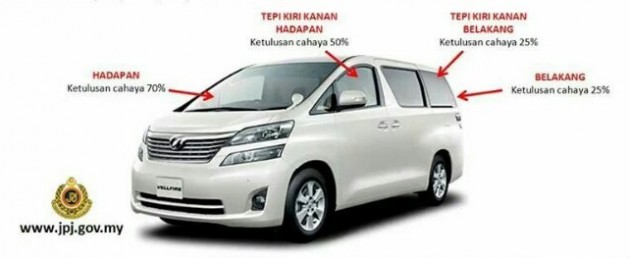The Auto Audio, Accessories and Air-Condition Traders Association of Malaysia (AAA) has urged the government to reduce the legal minimum Visible Light Transmission level (VLT) for the front windscreen of a vehicle from the current 70% to 60%, Bernama reports.
AAA exco member James Goh claimed that some passenger cars like the Proton Saga already have a front windscreen VLT of 72% before tinting, which effectively means no (more) windscreen tinting can be legally done.
“The issue here is not about fixing darker tint for front windshields but there are cars which have 72% VLT even before tinting and this has created problems to customers to have their cars tinted.
“Eventually, additional tinting works for cars which have VLT of 72% even before tinting will reduce VLT level and thus violate the minimum 70% VLT set by the government for front passenger car windshields. The value of VLT decreases as the tint darkens,” Bernama quoted him as saying.
New legal tint levels recently proposed by JPJ
Goh also suggested that the legal VLT of the side windows and rear screen be fixed at more than 40% as, he said, tints of below 35% VLT would make it difficult for authorities to carry out their enforcement duties.
“For instance, they cannot see if the driver is wearing the safety belt or not,” he said, adding that all VLT-testing devices should be uniformed and streamlined to ensure vehicle tints were within the legal limit.
The AAA will submit a memorandum to the Transport ministry on Tuesday on the requests made, said Goh.
Looking to sell your car? Sell it with Carro.




AI-generated Summary ✨
Comments generally support the AAA's proposal for a 60% VLT limit on front windcreens, emphasizing the importance of visibility for safety, especially in emergencies. Many express concern over darker tints, citing issues with rear visibility, tailgating, and the risks of not seeing in front cars and obstacles. Some highlight that existing factory tints already approach or exceed current legal limits, complicating tinting choices. Several comments mention health benefits from UV protection and cooling effects, advocating for better heat and UV rejection rather than darkness. Critics argue that excessively dark tints impair safety and visibility, especially during traffic conditions or emergencies, and some suggest the current VLT levels are already sufficient, with a few accusing industry lobbying and governmental inefficiency. Overall, there is a consensus favoring balanced tint regulations prioritizing safety and visibility.